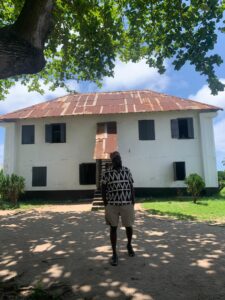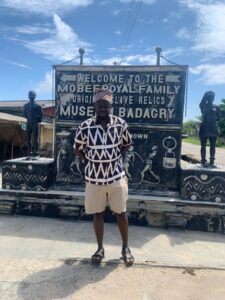Renowned Yoruba researcher, Adetona Oluwabunmi, recently undertook an emotionally charged expedition from Ibadan to Benin Republic to uncover the forgotten legacy of the Yoruba people of Oyo Ile, who were forcibly displaced during the transatlantic slave trade.
In an exclusive interview with DparrotNews, Adetona Oluwabunmi shares his captivating account, offering a personal and historical perspective on this pivotal moment in Yoruba history.”
Interviewer: may we meet you sir?
Adetona: My name is Adetona Oluwabunmi I’m a Yoruba researcher based in Ibadan, and my passion is uncovering the rich legacy of the Yoruba people. I wanted to reconnect with the lost Yoruba people of Oyo Ile who ended up in Benin Republic, especially through the dark era of the slave trade.
Interviewer: Adetona What inspired you to embark on this research project?

Adetona: The story of the Yoruba people stretches far beyond the borders of modern Nigeria, with deep roots in Oyo Ile, the heart of the old Oyo Empire. This journey began in Ibadan, the capital of Oyo State, and took me through several significant points in history and culture.



Interviewer: Can you describe your journey from Ibadan to Benin Republic?
Adetona Oluwabunmi: tracing the footsteps of my ancestors across borders and centuries. In my most recent research, I traveled to Benin Republic, following the trail of the lost Yoruba people from Oyo Ile—a journey filled with emotion, history, and deep reflection on the impact of the slave trade.
I started with a train ride from Ibadan to Agege, then by road from Mile 2 to Badagry. Badagry is a coastal town rich in history, immediately captured my attention. It’s a place where the Yoruba people from Oyo Ile and the Egun (Fon) people from Benin Republic coexist. The legacy of the slave trade still lingers in the atmosphere, and I knew this would be a deeply emotional exploration. In Badagry, I visited the Mobe Family Museum, the first storey building in Nigeria, and the Ark of No Return.




Interviewer: What was your most emotional experience during the trip?
Adetona Oluwabunmi: Lifting the real chains used during the slave trade at the Mobe Family Museum was overwhelming, I was allowed to touch and lift the real chains used during the slave trade. The experience left me speechless—how could anyone bear such heavy shackles for more than eight hours, let alone for days? This moment triggered a wave of emotions and raised questions in my mind about the humanity of those involved in the trade. Seeing the first Yoruba Bible at the first storey building helped calm my anger, but walking to the Ark of No Return and imagining the pain and sorrow of enslaved people brought me to tears. From the museum, I visited the first storey building in Nigeria, constructed in 1847 by European missionaries. It was later handed over to Samuel Ajayi Crowther, a significant figure in Yoruba history and the translator of the Bible into Yoruba. Among the many historical artifacts, I was struck by seeing the first Yoruba Bible, a testament to the strength of culture and language even in times of turmoil. One of the most moving parts of the trip was my journey to the Ark of No Return, where countless slaves had passed on their way to being sold into bondage. I walked for 45 minutes on sand, imagining the pain and sorrow of those who had been forced down the same path. Standing at the Ark, I couldn’t hold back tears, feeling the weight of history and the injustice done to my ancestors.
Interviewer: How do you think we should approach the legacy of the slave trade?
Adetona Oluwabunmi: Both European traders and local powers bear responsibility for this dark chapter. My research aims to highlight the complexities and nuances of this period.One should weigh the question of responsibility when its comes to slavetrade. Were the European traders solely to blame, or did some local powers bear responsibility as well? When I asked my tour guide, he offered a balanced view—both sides played a part in this dark chapter of history. This thought has reshaped my research




Interviewer: What do you hope to achieve with your research?
Adetona Oluwabunmi: I’m working on a book about the Oyo Empire and the slave industry, highlighting the benefits other Yoruba states gained from Oyo during that era. I want to challenge common misconceptions and showcase the resilience of my ancestors. Oyo Ile, the seat of the Oyo Empire, doesn’t get the recognition it deserves today. Many focus on the tributes collected by the empire, but they forget the protection and leadership Oyo offered the Yoruba people and other neighboring regions.
Interviewer: you said that this research has shaped your thoughts, in what way?
Adetona: In my research, I’ve identified five key benefits that other Yoruba states gained from Oyo during that era—benefits that are often overlooked. I’ll be sharing more about this in a video next month, but I want to emphasize that Oyo’s contributions were far more than just military strength or political dominance.
Interviewer: Tell us more of the discovery you made on your Journey
Adetona: The final stop of my research journey was in Badagry, the Brazilian Baracoon, a site used by Portuguese traders to store enslaved people before shipping them abroad. The 10-by-10-foot room, which held 40 slaves for over 100 days, was horrifying. My anger, which had calmed earlier, returned with full force, and I found myself speechless as the tour concluded.
Interviewer: What’s next for your research?
Adetona Oluwabunmi: I’ll be heading to Benin Republic, where I plan to visit Ouidah, also known as the “Slave Town,” and the Point of No Return. This trip will continue to shape my understanding of the slave trade, the lost Yoruba people, and the resilience of my ancestors. I invite you to keep me in your prayers as I continue this research and share more insights in the coming months.
Interviewer: Thank you, Adetona, for sharing your powerful story and insights.
Adetona Oluwabunmi: Thank you for having me.
...Never miss an update again! Join our WhatsApp group for the latest news, straight to your phone! (Click Here)




